Chicken Chimichurri is crazy juicy, dripping with flavor and can be grilled, pan-fried or baked with just minutes of hand’s-on prep!
Chimichurri Chicken is vibrant, garlicky, tangy, spicy, oh so tender and about to become one of your go-to chicken recipes! It is marinated in a zesty, herb-infused chimichurri sauce originating in Uruguay and Argentina that takes just 5 minutes to whip up. After marinating, you will love that all you have to do is cook the chicken and dinner is served! The Chicken Chimichurri is stand-alone scrumptious with roasted veggies or grilled zucchini or fabulous in salads, sandwiches or wraps. Let’s chimichurri!
We love chicken marinades! They are the easiest way to infuse chicken with flavor and make dinner time a breeze. Some of our most popular chicken marinades include: best grilled chicken marinade, Greek chicken, cilantro chicken, chili lime chicken, Hawaiian chicken ,buffalo chicken and now you can add this chicken chimichurri to the list.
PIN THIS RECIPE TO SAVE FOR LATER
WATCH: How to Make Chimichurri Chicken
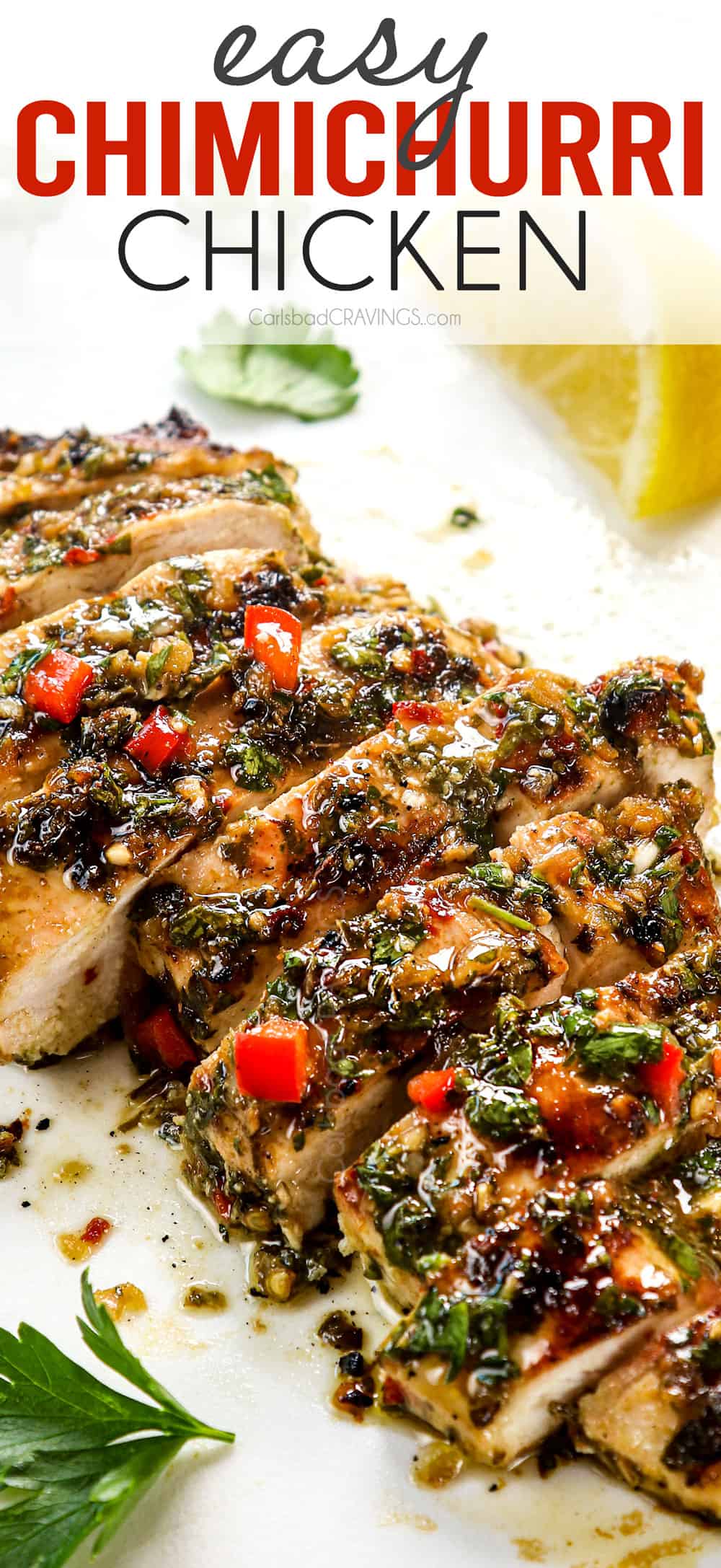

Why You’ll Love this Chimichurri Chicken Recipe
No more boring chicken! This Chimichurri Chicken boasts dynamic punches of tart, garlicky, spicy, herbaceous flavor in every juicy, exhilarating bite. It’s guaranteed to be a huge hit and become one of your most requested go-to chicken recipes.
The marinade does all the work! Just a few simple ingredients and five minutes are all you need to make the transformative tangy chimichurri sauce. Then sit back and relax as it works its magic to create tender, juicy chicken, dripping with flavor from the inside out. Now just cook the chicken– it couldn’t be any easier!
It’s hand’s-off fabulous for entertaining. The easy marinade makes YOUR life easier and is always a crowd pleaser! Just slap your chicken on the grill when guests arrive and in minutes, you’ll have tender, juicy, intoxicatingly delicious chicken.
This recipe makes dinner guilt free delicious. This Chicken Chimichurri boasts lean chicken breasts marinated in ingredients like parsley, oregano, red-wine vinegar, red chili peppers and olive oil then grilled to perfection for a high protein, low carb, satisfying dinner dripping with flavor. Just add a side of veggies for a nutritious, guilt free dinner.
It can be cooked using any method year-round. Chimichurri Chicken screams summer but I’ve also included instructions for baking and cooking on the stove so you can make it year-round – because you are going to want to eat it year-round.
This Chicken Chimichurri can be customized just how you like it. Make it tangier, spicier, less spicy, etc.
It’s so versatile and great for meal prep. Serve the chicken plain with potatoes/rice and veggies, in wraps, grain bowls, salads, sandwiches, etc. I love making a big batch of this recipe to serve in countless ways throughout the week.
It’s easy to scale up or down. This recipe is easy to double or triple for entertaining, for purposeful leftovers or to freeze.

Is this Authentic Chicken Chimichurri?
Authentic Argentine chimichurri is commonly made with olive oil, finely chopped parsley, oregano, red wine vinegar, garlic, and red chili peppers. I stay true to these ingredients, but I prefer to swap some of the parsley for cilantro, some of the red wine vinegar for lemon juice and add a shallot. These small changes create a more dynamic sauce, in my opinion, but you are welcome to stick with all parsley, red wine vinegar and omit the shallots if you wish.
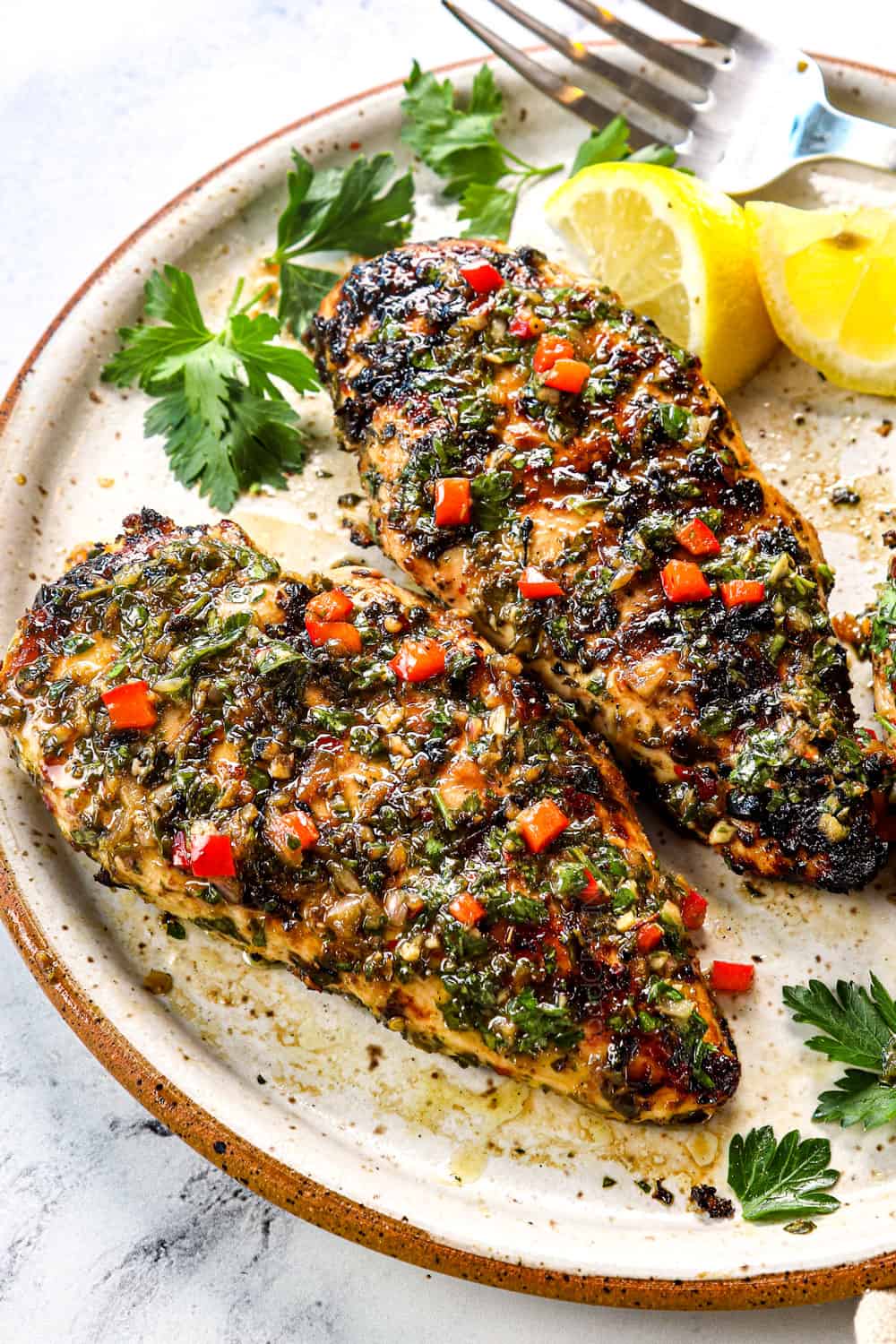

WHAT IS CHIMICHURRI CHICKEN?
Now that we’ve established Chicken Chimichurri is delicious, what exactly is it? Chimichurri is a vibrant herbaceous, tangy, zingy, garlicky
uncooked herb and oil sauce, condiment and marinade originating in Argentina and Uruguay, popular throughout South America. It has a similar consistency and method of preparation as pesto but a zippier, tangier, spicier flavor profile.
While the ingredients vary by region, chimichurri is commonly made with fresh parsley, oregano, garlic, olive oil, red wine vinegar, chili peppers or flakes, salt and pepper. Red wine vinegar imparts a vibrant sharpness, verdant parsley packs the herbaceous punch, oregano fortifies with earthy, peppery assertiveness, garlic injects the pungent flair and red chili peppers pump in the heat. The sauce is riddled with strong flavors which are married together by the glassy olive oil to create a lovely, cohesive depth of flavor.
To create Chimichurri Chicken, some of the sauce is marinated with the chicken and the rest is draped over the cooked thicken to ensure every bite is jam packed with tangy, bright herbal freshness.
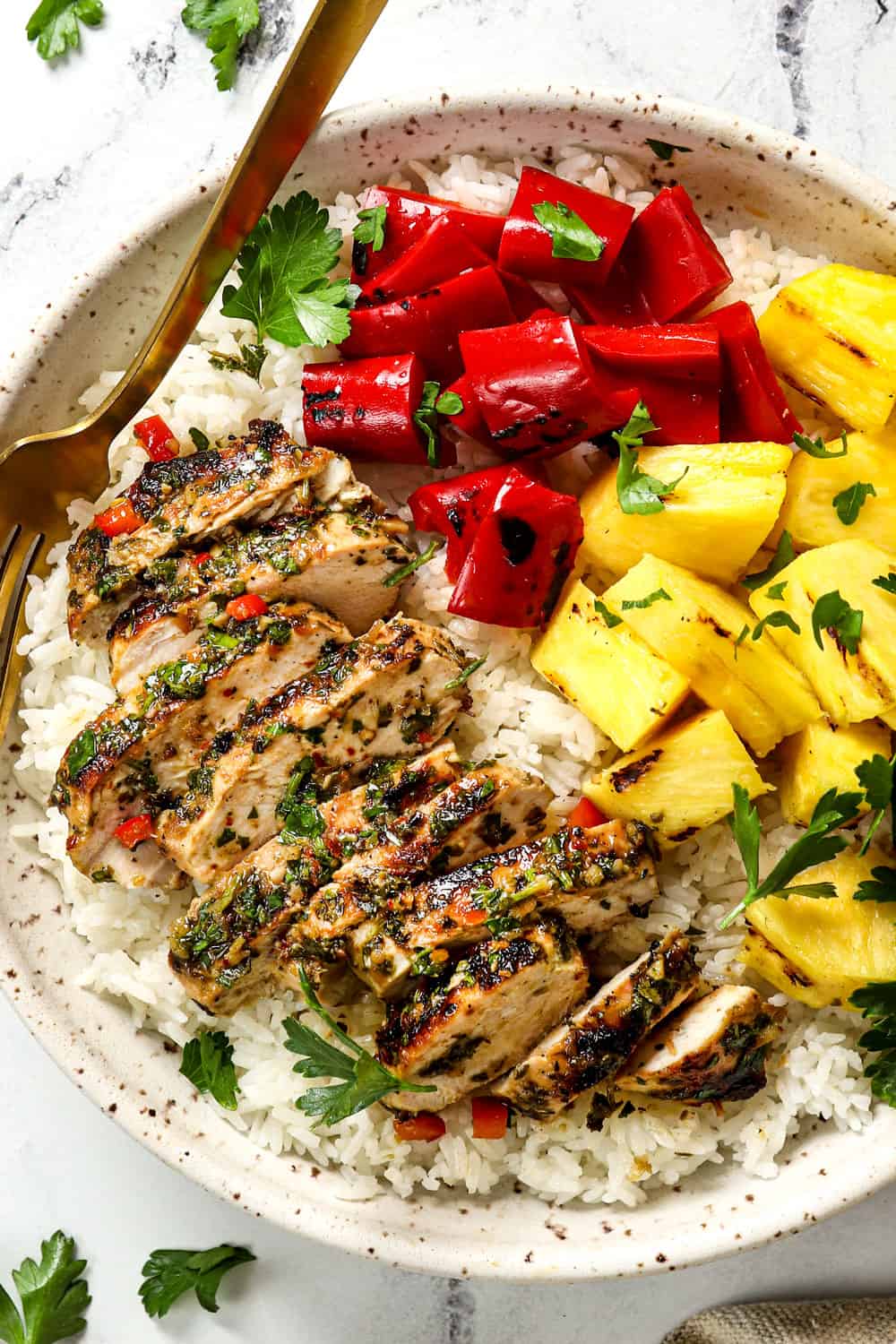
CHICKEN Chimichurri INGREDIENTS
The Chimichurri Sauce is the star of this Chimichurri Chicken recipe. It is used both as the marinade and the finishing sauce. The good news is this this bright, flavor packed sauce is incredibly quick and easy to make in your food processor with just few ingredients like parsley, oregano, red-wine vinegar, red chili peppers (or flakes) and olive oil. Let’s take a closer look at what you’ll need to make it (full recipe measurements in the recipe card at the bottom of the post):

What Chicken to Use for Chimichurri Marinated Chicken?
This Chicken Chimichurri will work with any cut of chicken including chicken breasts, chicken thighs, chicken tenderloins, chicken drumsticks, chicken legs or chicken wings. You will just need to adjust the cooking times if you swap out the cut of chicken, so keep that meat thermometer handy!
In this particular version, I’ve gone with chicken breasts because they are my husband’s favorite. Chicken breasts work extremely well in this recipe because the marinade is rich in olive oil which helps create richer, juicier chicken breasts than many other grilled chicken recipes. You will be amazed at how juicy they become!
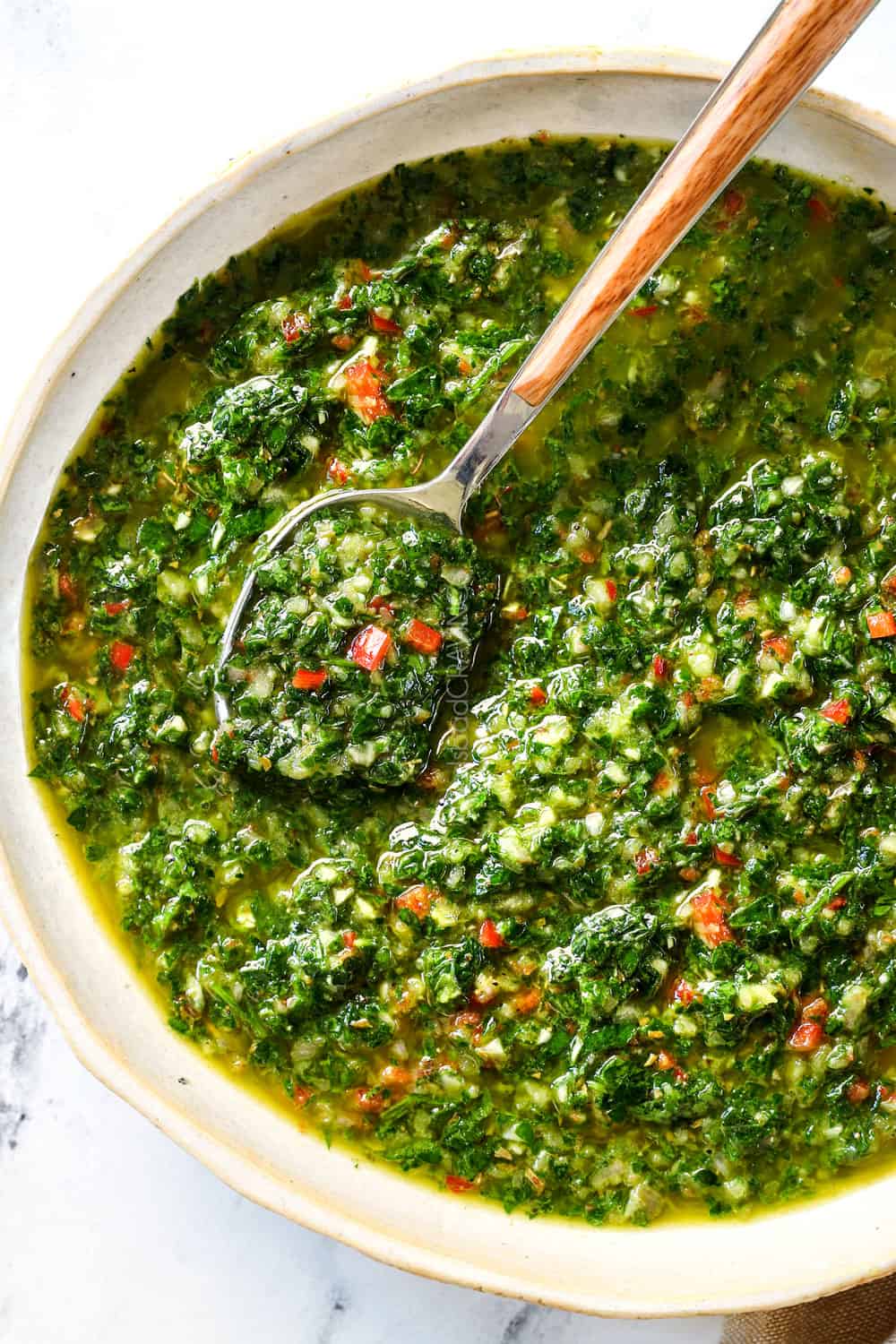
HOW TO MAKE CHIMICHURRI Chicken
Chimichurri Chicken is extremely easy to make with an assist from the food processor. However, you are welcome to chop all of the ingredients by hand and combine them in a bowl if you wish.
Step 1: Make Chimichurri
- Finely chop aromatics. We want to chop the shallot and garlic first along with the vinegar and lemon juice to make sure the aromatics are finely minced before adding the parsley.
- Chop herbs. Add parsley, cilantro and oregano. Pulse several times to chop.
- Pour in the olive oil. Add the olive oil while the processor is running in order to emulsify the olive oil and red wine vinegar. An emulsion is simply a blend of two liquids that don’t normally bind together. The beauty of emulsification is that it creates a cohesive sauce. Don’t overmix or the olive oil can oxidize and become bitter.
- Reserve some chimichurri. Remove ⅓ cup chimichurri sauce to use as a topping for the cooked chicken.
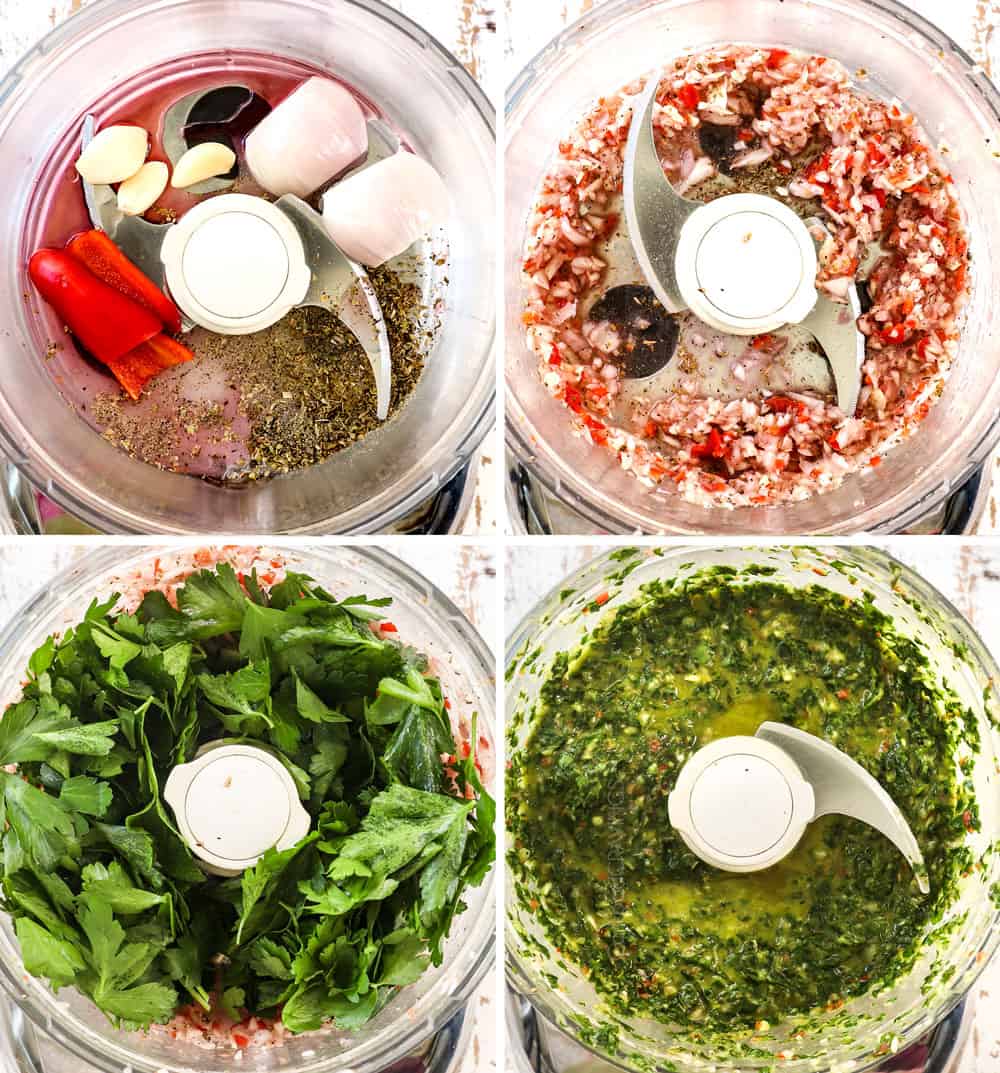
Step 2: Marinate Chicken
- Pound chicken to an even thickness. Place chicken breasts in-between two pieces of plastic wrap and pound to an even thickness using the flat side of a meat mallet, rolling pin or side of a can.
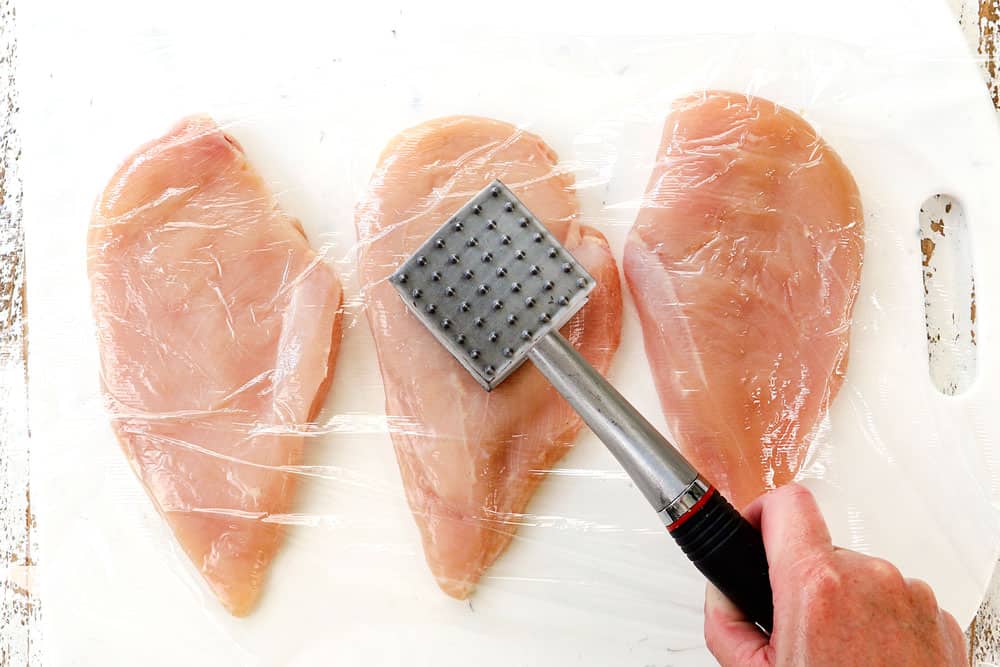
- Combine chicken and chimichurri. Transfer chicken to a freezer size bag or large bowl and toss evenly with the remaining chimichurri.
- Marinate chicken. Marinate chicken at room temperature for 30 minutes if you’re short on time or up to 12 hours in the refrigerator.
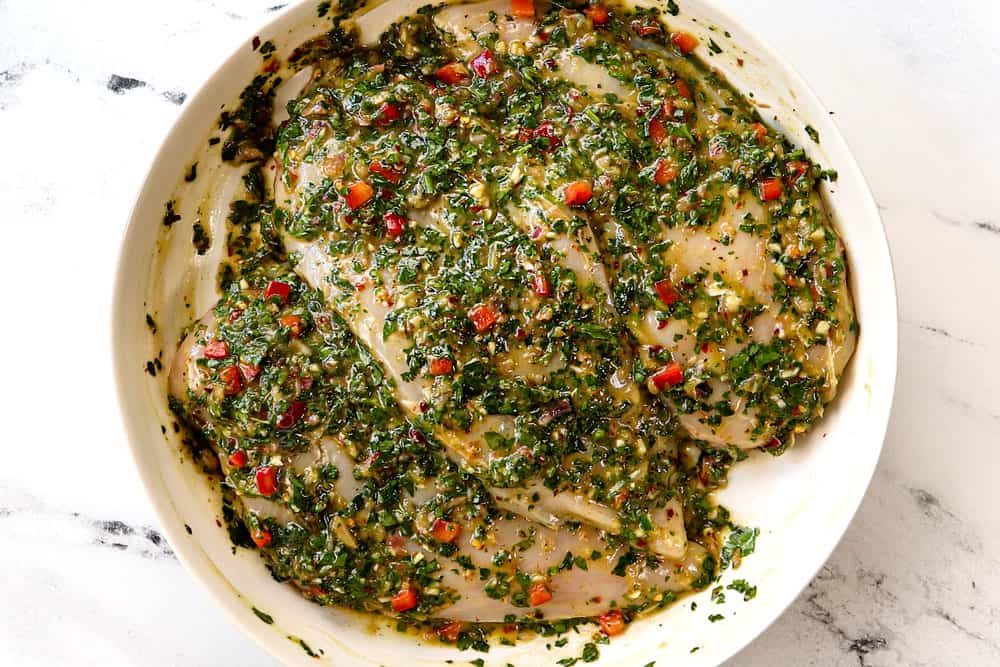

Chicken with Chimichurri marinating tips
HOW LONG DO YOU MARINATE CHICKEN?
Chimichurri Chicken is best if allowed to do its thing for at least four hours so the chicken can reap the benefits of the tenderizing properties, but I would aim for at least 6 hours for maximum benefit.
CAN I MARINATE CHICKEN TOO LONG?
You can marinate the Chicken Chimichurri for up to 12 hours, but don’t push it too much longer than that, otherwise the acid in the marinade can break down the muscle fibers too much and make your chicken mushy.
SHOULD YOU POKE HOLES IN CHICKEN BEFORE MARINATING?
No, you should NOT poke holes in the chicken before marinating. This actually drains out the valuable juices and will result in less juicy chicken. You can cut slits in thick pieces of chicken like chicken legs to reach deeper into the protein, but never holes.
WHAT CONTAINERS SHOULD I MARINATE CHICKEN IN? I prefer food-safe sealable plastic bags such as freezer Ziploc bags. They really allow the marinade to envelop the chicken vs. a dish in which the marinade might not cover all of it. When using a plastic bag, make sure to squeeze out excess air before sealing then roll up the bag so the chicken is nice and snug. Sealable bags are also great for easy cleanup – just toss them! You may also use food grade plastic, stainless steel, or glass containers and cover with plastic wrap if they don’t have a lid. If you marinate the chicken in a shallow dish, make sure to flip the chicken over occasionally so it marinates evenly.
SHOULD MARINATING CHICKEN BE KEPT IN THE FRIDGE? Always marinate chicken for a prolonged period of time covered in the refrigerator and not at room temperature to avoid food-born illness. Only remove the chicken from the fridge to the counter 30 minutes before you’re ready to grill to help bring it to room temperature so it cooks more evenly.
CAN YOU FREEZE CHICKEN IN THE MARINADE?
Yes! If you can’t get to cooking your marinating grilled chicken within 12 hours, just pop it in the freezer – another perk of using sealable plastic bags. When it’s time to cook, just thaw and cook immediately. You don’t want the chicken to marinate again or it can become mushy.
HOW TO COOK CHICKEN CHIMICHURRI
This Chimichurri Chicken is so tasty and versatile, you’re going to want to serve it year-round! Here’s a few different cooking methods to meet your year-round needs:

TO GRILL CHICKEN
1. Remove chicken from the refrigerator and let rest 15-30 minutes before grilling. Meanwhile, preheat grill to 400 degrees, clean and grease grates.
2. Grill chicken undisturbed with the lid closed for 5-7 minutes per side, or until chicken is cooked through. (An inserted thermometer should read 160 degrees F, then allow to rest for 5 minutes to carryover to 165 degrees F.)
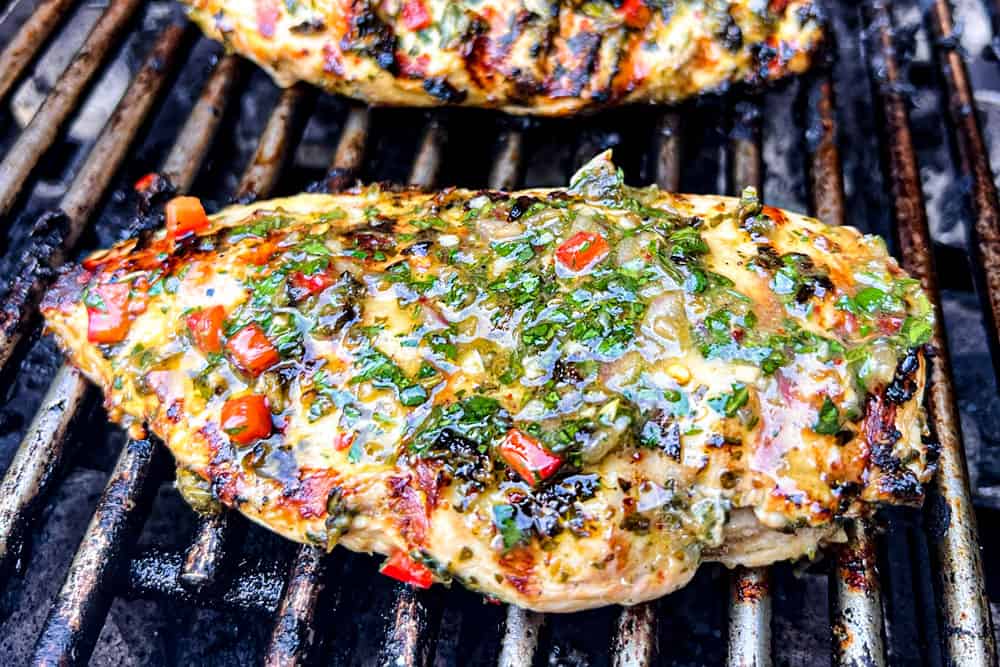
TO COOK CHICKEN ON THE STOVE
1. Remove chicken from the refrigerator and let rest 15-30 minutes at room temperature.
2. Heat 1 tablespoon olive oil in a large non-stick skillet or grill pan over medium-high heat. Once very hot, add chicken and cook, undisturbed, for 3-4 minutes, or until deeply golden on one side.
3. Flip chicken over, cover, and reduce heat to medium. Cook for approximately 5-7 more minutes (depending on thickness of chicken), or until chicken is cooked to 160 degrees F, then allow to rest for 5 minutes to carryover to 165 degrees F.
TO BAKE CHICKEN IN THE OVEN
1. Remove chicken from the refrigerator and let rest 15-30 minutes at room temperature.
2. Meanwhile, preheat oven to 425 degrees F and lightly grease a baking dish with cooking spray.
3. Bake the chicken for 14 to 16 minutes (for small/medium breasts that are about 5-6 ounces), 16 to 20 minutes (for medium/large breasts that are 7 to 9 ounces), or 20 to 25 minutes (for larger breasts). As always, I recommend using an instant read meat thermometer for the most accurate/juiciest chicken. Cook to an internal temperature of 160 degrees F, then allow to rest for 5 minutes to carryover to 165 degrees F.

Chimichurri Chicken Breast Variations
This Chicken Chimichurri recipe is extremely versatile. Feel free to go rogue and make it completely your own by adjusting the amounts of chimichurri ingredients or swapping ingredients. Here are a few ideas:
- Go all parsley: Swap the cilantro for parsley.
- Play with green proportions: Add more cilantro instead of the parsley or vice versa.
- Basil chimichurri: Swap all or some of the parsley or cilantro for basil.
- Use other greens: Swap in a different green for the cilantro and/or parsley such as fresh dill, mint, kale, chard, arugula mustard greens and more.
- Customize spice level. In most regions, chimichurri is meant to be spicy but you can customize the heat. The following is for Fresno peppers; if you use a smaller/spicier pepper, you’ll need to use less. If you know you don’t like heat, start with half of a chili pepper. If you know you like some heat, start with one chili pepper. If you know you love heat, start with 2 chili peppers. Add some of the seeds to taste if you would like it spicier. Remember the sauce will have more of a kick when you taste it plain but will mellow when combined with whatever you’re serving it on or with.
- Use red chili flakes instead of fresh peppers. You may substitute the fresh chilies with ½-1 teaspoon of dried red chili flakes. Start with a little then add more to taste.
- More or less garlic: If you like more of a garlic forward chimichurri recipe, use 4 garlic cloves. If you like milder garlic, start with 2 cloves. After the chimichurri is mixed and allowed to rest for 15-30 minutes, you can taste and add more finely minced garlic if you prefer.
- Customize consistency. Add more or less olive oil depending on how thick or thin you prefer your chimichurri. If you would like additional olive oil after the sauce is mixed, stir it in, rather than blend it to avoid bitter over-oxidation.
- Season to taste. You may prefer a more garlicky sauce, a tangier sauce or spicier sauce, so be prepared to make it your own.
- Asian chimichurri: I’ve served Asian chimichurri with both Asian steak and Asian salmon and it was phenomenal. Swap the parsley for cilantro, basil and mint, red wine vinegar for rice wine vinegar and oregano for ginger, and add a splash of fish sauce and toasted sesame oil.

Tips for cooking the juiciest Chimichurri Chicken
Don’t skip pounding the chicken! Not only does this help the chicken cook evenly but it tenderizes it as well. If you don’t have a meat mallet, you can use the side of a can or rolling pin.
Bring chicken to room temperature before cooking. Transfer the marinating chicken to your kitchen counter 30 minutes before grilling. Room temperature chicken cooks more evenly and quickly which translates into juicier chicken because there is less time for moisture to be released while cooking.
Use a clean, hot grill. Heat up the grill with the lid closed cranked to the maximum temperature so it can achieve temperature more quickly; plan on 10-15 minutes. Once the grill is hot, adjust the temperature and clean with a wire grill brush to remove any residue if needed. Don’t add the chicken until the grill reaches temperature or you won’t get those beautiful grill marks.
Flip only once using tongs. After you add the chicken breasts to the grill, don’t touch them for a full 5 minutes. You need enough time for the chicken to sear and then they will naturally release from the grill. Once you can easily move the chicken, then you can flip it over using tongs.
Don’t overcook! Chicken breasts are a lean protein and therefore can dry out if overcooked. Use a meat thermometer to eliminate all of the guess work to achieve succulent, juicy chicken every time.
Let chicken rest. Let the cooked chicken rest for 5 minutes before slicing. This gives the juices that have pushed to the outside of the meat time to redistribute throughout the chicken. If you cut into the chicken immediately after cooking, valuable, moisture-giving juices will run out.
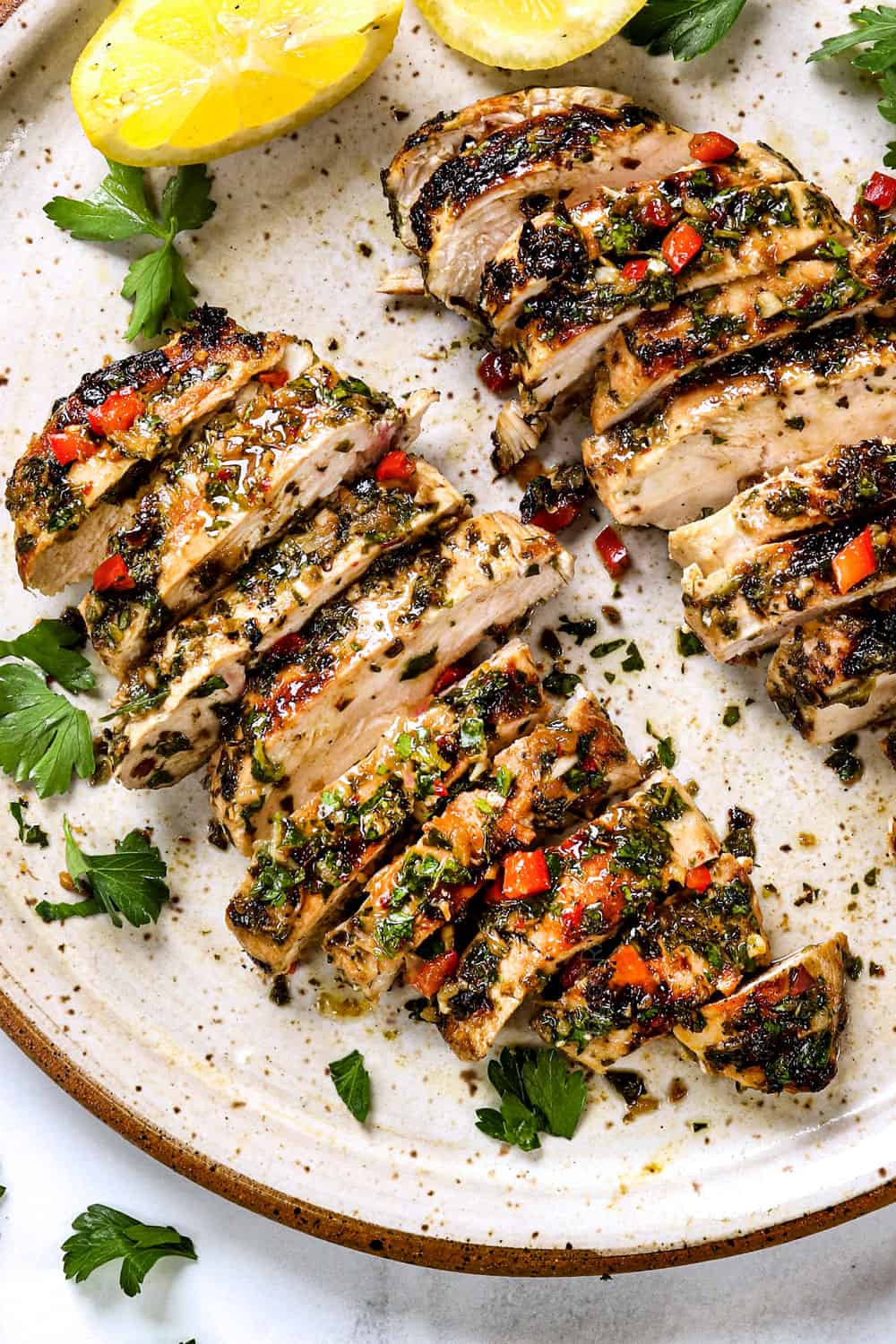

How to Not Overcook Chicken Chimichurri
Overcooked chicken is dry chicken. The only way to ensure perfectly cooked, juicy chicken every time is to use a meat thermometer, otherwise you have to slice open the chicken and lose valuable juices. Additionally, chicken pieces can cook at different rates, so a thermometer allows you to remove each piece as soon as it’s cooked.
You can pick up an inexpensive instant read thermometer at the grocery store or Amazon, or I am obsessed with this digital probe thermometer – you will never overcook any protein again! Instant read thermometers can be temperamental, but this digital probe thermometer retrieves temperature precisely to within ±1.8°f (±1°c) and allows you to insert a probe into two pieces of chicken/any protein at a time.

WHAT TEMPERATURE SHOULD CHICKEN BE COOKED TO?
Chicken breasts and chicken tenders (light meat) are done via any cooking method when they register 160 degrees F on an instant read thermometer and then allowed to rest to reach 165 degrees F. Insert the thermometer into the thickest part of the chicken – although hopefully you don’t have one because your chicken has been pounded to an even thickness ;).
Chicken thighs and legs (dark meat) are safe to eat when their internal temperature reaches 165 degrees F but they are juicier and more tender when cooked to 170-175 degrees. F. Chicken thighs contain more connective tissue than chicken breasts which takes longer to break down. Cooking them to a higher temperature will ensure that the dark meat becomes even more tender and juicy verses chewy and rubbery. Insert the thermometer into the thickest part of the chicken, make sure not to hit any bones if using bone-in thighs. Bones are a heat conductor and will register higher than the actual meat.

Chimichurri Chicken Recipe tips
Chicken Chimichurri is very simple to make but here are some helpful tips the the juiciest chicken every time:
Taste the parsley. Chimichurri sauce can taste bitter if the parsley is bitter to start with, so I recommend tasting the parsley first so you don’t ruin an entire batch. This is more likely with curly parsley that is not fresh.
Don’t over-process the parsley. The chimichurri sauce should not be pureed into an herb mash or thick paste. Rather, the parsley should still have body and texture and there should be enough oil (because it’s not pureed) to be a loose, oil-based condiment and marinade.
Don’t over-process the olive oil. Only pulse the oil a few times in order to combine. If you over-process the oil, its polyphenols can break away from the fatty acids causing oxidation which will make the chimichurri taste bitter. If you’re worried about this, you may stir the olive oil in by hand.
Adjust chimichurri sauce recipe to your taste. If you’re not sure how strong, spicy or tangy you would like your chimichurri sauce, start with small amounts and gradually add more to taste. You can always add more garlic, salt, pepper, chili vinegar, etc., but they’re hard to take away.
When adding more ingredients to taste, mince them by hand. Don’t add whole ingredients to the already chopped chimichurri sauce in the food processor or it will become over-processed. Instead, chop the ingredients then stir them in by hand.
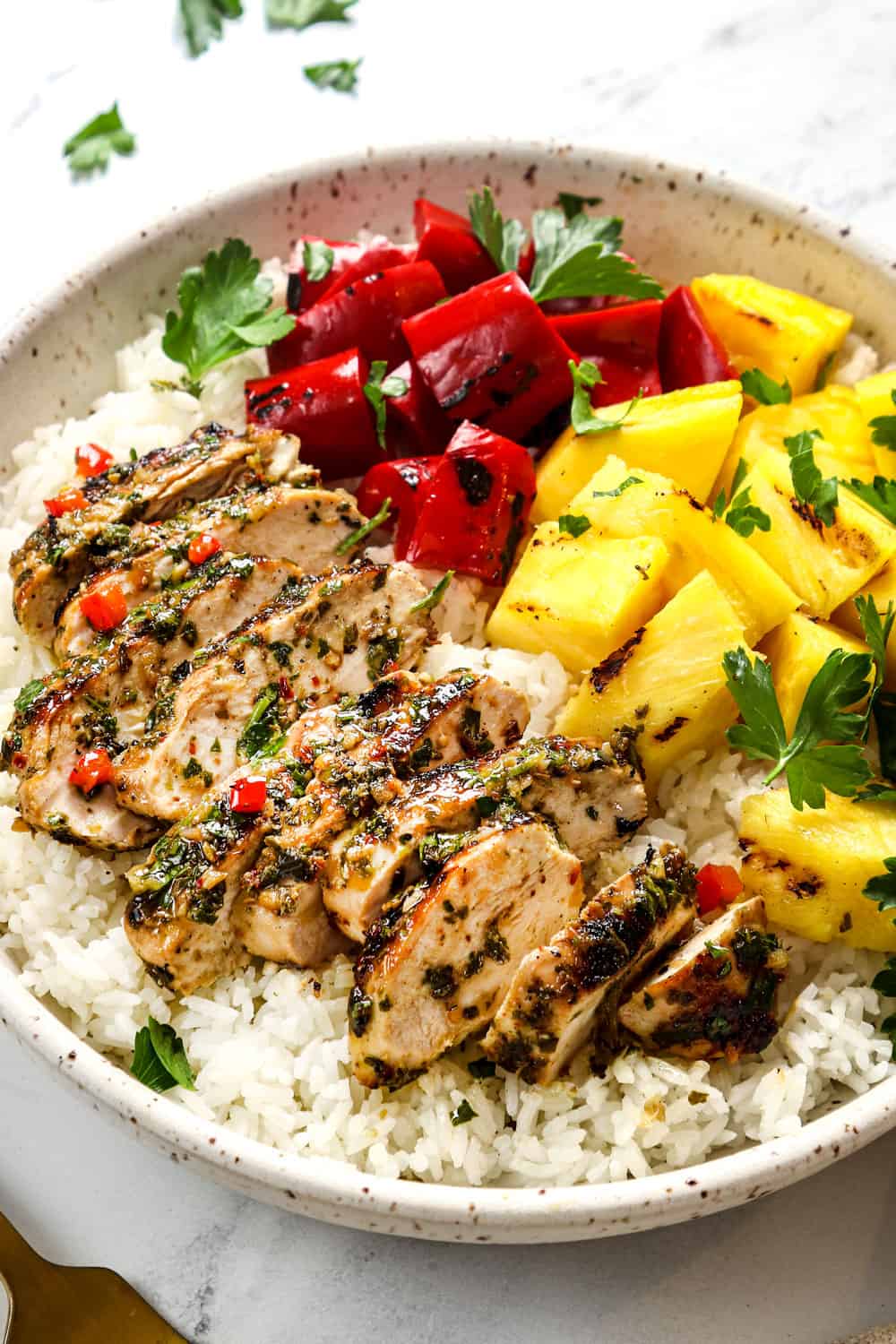

what to serve With Chimichurri Chicken
This Chicken Chimichurri pairs well with everything from salad to pasta salad, potatoes, rice and fruit. In the summer months, we keep it as simple with rice, grilled bell peppers and pineapple. In the winter, I love it with garlic butter mashed potatoes and roasted asparagus. Here are a few of our favorite accompanying sides
Rice: Serve Chicken Chimichurri with Coconut Rice, Pineapple Rice, white rice, brown rice, quinoa, cauliflower rice or broccoli rice for a neutral textural side that soaks up the sauce and allows the flavors to shine.
Salsa: Another favorite side with this tangy chicken is tropical sweet salsa such as Pineapple Salsa, Pineapple Mango Salsa, Pineapple Blueberry Salsa, or Mango Salsa.
Fruit: If you skip the fruit salsa, go with simple grilled pineapple or more exotic Grilled Brown Sugar Pineapple, Pina Colada Fruit Salad, Tropical Fruit Salad, Summer Fruit Salad, Perfect Fruit Salad, or Creamy Grape Salad,
Veggies: Grilled, roasted, steamed, or stir-fried veggies are fantastic with this recipe. I love throwing bell peppers on the grill alongside the chicken or making veggie skewers. You can even make extra chimichurri to toss with the vegetables. Grilled Corn on the Cob is also always a welcome addition.
Salad: Go with a simple green salad or more elaborate Corn Salad, Strawberry Salad, Strawberry Broccoli Salad, Watermelon Salad, Asian Pineapple Salad or Ramen Noodle Salad.
Pasta Salad: BLT Pasta Salad, Bacon and Pea Pasta Salad, Strawberry Avocado Pasta Salad would all be delish.

Ways to USe Chimichurri Chicken
This Chicken Chimichurri is fabulous on its own or it can be added to salads, wraps, sandwiches, etc. Here are just a few ideas for freshly cooked chicken or to reimagine leftovers:
Chimichurri Chicken Tacos: Add chopped chicken to a charred tortilla along with desired toppings such avocado crema or guacamole, and a tropical salsa such mango salsa, or pineapple salsa.
Chimichurri Chicken Quesadillas: Sandwich chicken, Monterrey Jack Cheese, black beans and cilantro in between two flour tortillas and toast in a skillet to golden, cheesy perfection. Serve with pineapple salsa or mango salsa, pico de gallo, avocado crema, and/or sour cream.
Chimichurri Chicken Salad: Chop up the chicken and add it to your favorite greens along with veggies such as sweet grilled corn, peppers and tomatoes. Throw in some cashews or macadamia nuts for crunch, avocados for creaminess, black beans for hearty earthiness and pineapple for sweetness. Use the reserved marinade as a dressing thinned out with additional olive oil.
Chimichurri Chicken Pasta Salad: Chop up the chicken and add it to cooked medium pasta with your favorite fixings such as cherry tomatoes, cucumbers, bell peppers, Kalamata olives, etc. Dress the salad with reserved chimichurri sauce combined with additional olive oil or add the reserved chimichurri to sour cream and mayonnaise to create a creamy sauce.
Chimichurri Chicken Sandwiches: Sandwich the cooked chicken in between bread and pile with toppings such as pineapple, tomatoes, bacon, avocado, lettuce, sprouts, guacamole, etc. Use the reserved chimichurri as a spread combined with mayonnaise or Greek yogurt.
Chimichurri Chicken Panini: Brush the outsides of ciabatta with olive oil, smother the insides with chimichurri combined with mayonnaise then load with sliced tomatoes, fresh mozzarella and chicken. Add any additional toppings such as avocado, bacon, sprouts, etc., etc. then press in a panini press. If you don’t have a panini press, cook the sandwich like a grilled cheese in a skillet with melted butter instead.
Grilled chicken wraps: Slather a tortilla or flatbread with yogurt and/or mayo combined with chimichurri then pile with lettuce/mixed greens, chopped pineapple, sliced tomato, chicken and desired toppings such as cucumbers, avocado, bacon, etc.
Chimichurri Chicken Grain Bowl: Top your favorite grains (rice, couscous, quinoa etc.) with chopped chicken, black beans, grilled and/or roasted veggies, and your favorite toppings such as pineapple or mangos or mango salsa, or pineapple salsa, guacamole, shredded greens, charred corn, pickled red onions, pickled beets, sliced almonds, etc.

How to Meal Prep Chimichurri Chicken
Chimichurri: The marinade/sauce will last up to 7 days in the refrigerator (without the chicken) but is at peak freshness the first day it is made. This means you can whip up the sauce then marinate the chicken when ready.
Chicken: The cooked chicken will last up to 5 days in the refrigerator. I like to slice all of the chicken super thinly then it’s ready to be added to bowls, salads or sandwiches throughout the week. You can also pre-assemble salads, grain bowls, etc.

How to Store Chicken with Chimichurri
Storage: Store cooked chicken in airtight containers in the refrigerator for 4-5 days.

How to Reheat Chimichurri Chicken Breast
Microwave: Chop up or slice the chicken so it reheats more evenly then transfer a small portion to a microwave safe dish. Heat for 45 seconds then at 15 second intervals as needed.
Oven: Transfer chicken to an oven-proof dish. Cover with foil and reheat at 350 degrees F for 10 minutes or just until warmed through.

How to Freeze Chimichurri Chicken
You can freeze uncooked chicken in the marinade or after it’s cooked:
Option 1: Freeze chicken in marinade: Add the chicken to the chimichurri in a freezer safe bag, squeeze out excess air and freeze for up to 3 months. When you’re ready to use, the chicken will marinate as you thaw the chicken in the refrigerator; cook immediately so it doesn’t marinate for too long and become mushy.
Option 2. Freeze chicken: Let the cooked chicken cool completely then transfer it to an airtight container or plastic freezer bag and squeeze out any excess air. If you want access to individual pieces of chicken without having to thaw all of the chicken, then wrap each chicken breast in plastic wrap before adding to the freezer bag. Freeze for 2 to 3 months.
Chimichurri Marinated Chicken Recipe FAQs
Now that we’ve established Chimichurri Chicken is delicious, what exactly is it? Chimichurri is a vibrant, zingy, uncooked herb and oil sauce originating in Argentina and Uruguay, popular throughout South America. Chimichurri is made with a variety of herbs, garlic and olive oil; the name and color change depending on the herbs and spices used (chimichurri verde or chimichurri rojo).
This herbaceous sauce has a similar consistency and method of preparation as Chimichurri but a zippier, tangier and often spicy flavor profile. It can be used as a condiment, dressing or marinade like in this Chicken Chimichurri recipe.
Chimichurri, like many condiments with a long history, has many variations depending your region, preferences and pantry. However, purists will claim classic Argentinian chimichurri includes only fresh parsley, oregano, garlic, olive oil, red wine vinegar, chili peppers or flakes, salt and pepper.
Many non-authentic chimichurri recipes include white or red onion, shallots, cilantro, basil, lemon juice, cumin, coriander, and paprika. I have even made mango chimichurri with cilantro and Asian chimichurri with mint and fish sauce!
A nod to chimichurri rojo: While green chimichurri (chimichurri verde) is the more well-known version of chimichurri in the states, you will also find a red chimichurri (chimichurri rojo) in Argentina as well. It is made with similar ingredients with the inclusion of roasted red peppers and smoked paprika which add the red color and a smoky flavor.
Chimichurri’s bright flavors cut through the savory, richness of Argentina’s world-renowned grilled cuts of flank steak or any grilled proteins. It’s tangy, zingy, garlicky, a tad bit spicy, and jam packed with bright herbal freshness. It is a flavor bomb that ensures everything it touches is dripping with flavor.
Red wine vinegar imparts a vibrant sharpness, verdant parsley packs the herbaceous punch, oregano fortifies with earthy, peppery assertiveness, garlic injects the pungent flair and red chili peppers pump in the heat. The sauce is riddled with strong flavors which are married together by the glassy olive oil to create a lovely, cohesive depth of flavor.
Chimichurri sauce is served at room temperature over hot meats or veggies so its tapestry of flavor can really shine.
Chimichurri’s etymology is steeped in lore, but the famous sauce was most likely first connoted by gauchos (cowboys), who used it to jazz up the meat they grilled over open fires while on the pampas.
Others claim it originated with a nineteenth century Irish solider named “Jimmy McCurry” who was either a freedom fighter or meat trader traveling with indigenous troops fighting for the independence of Argentina. Because his name was difficult for Argentines to pronounce, “Jimmy’s curry” got turned into chimichurri.
More likely, however, the name comes from the Basque country word tximitxurri, meaning “a mixture of several things in no particular order.”
Like many recipes, chimichurri varies from region to region. In some areas of Argentina, chimichurri is heavy on garlic and light on spice, in other areas, it is light on garlic and heavy on spice; in some areas, it doesn’t contain red pepper flakes at all! In the United States, however, chimichurri is increasingly seen as a spicy herb sauce. The chili flakes cut through and compliment sauce’s tangy, robustness. The beauty about making your own chimichurri recipe, however, is that you can customize the spice level. If you’re sensitive to spicy foods, start with less chili flakes and add more to taste.
Chimichurri Chicken is made with chicken breasts which are low in carbs and high in lean protein. The sauce is packed with healthy ingredients like parsley and garlic which translates to loads of good-for-you benefits, including calcium, carotenes, iron, fiber and vitamins A, C, E and K. It is naturally low in carbs and sugar-free. The base of the sauce, however, is olive oil, which is a heart-healthy monounsaturated fat, which means it is high in calories and should be enjoyed in moderation.
Chimichurri Chicken can taste bitter either because 1) the parsley is bitter to start with and has tainted the sauce, or 2) the sauce was overmixed with the olive oil causing oxidation. To prevent bitter chimichurri, make sure to taste the parsley before using and don’t mix the olive oil at too high of a speed or for too long or the polyphenols in the olive oil break away from the fatty acids resulting bitter tasting chimichurri.
Yes, when measuring parsley, chop the leafy top of the bunch away from the bottom stems, but you don’t need to remove the leaves from the stems.
Chimichurri sauce is made of fresh herbs so it can go bad quickly if not refrigerated. When refrigerated it can last up to 7 days. You’ll know your chimichurri has gone bad once it tastes bitter, caused by either the herbs or the oil breaking down.
Both pesto and chimichurri are herb, garlic, olive oil-based sauces, but the similarities stop there. Chimichurri is primarily made of parsley, whereas, pesto is made of basil. Chimichurri is tangy and spicy due to the addition of red wine vinegar and red chili flakes, whereas pesto is earthy, nutty and salty due to the addition of Parmesan and pine nuts. Chimichurri is most commonly used as a marinade for meats or for basting or draping grilled meats, whereas pesto is most commonly used in pasta dishes.
This recipe will marinate 1 ¼ pounds (20 oz.) of chicken, however, it is easy to scale up or down to suite your needs by using the sliding scale next to the servings in the recipe card.
4 ounces of chicken is the recommended single serving portion of chicken, but this varies depending on the individual and what sides are being served. I would say 6-8 ounces is closer to realistic.
No, traditional chimichurri sauce does not typically contain nuts. Chimichurri is a South American condiment made with fresh herbs, garlic, vinegar, oil, and spices. The basic ingredients include parsley, garlic, oregano, red wine vinegar, olive oil, and red pepper flakes. While the traditional recipe doesn’t include nuts, variations or personal adaptations may incorporate ingredients like nuts for added texture or flavor.


More like this Chimichurri Marinated Chicken Recipe
–Greek chicken marinade: bright, vibrant with a delightful lemon/oregano flavor.
Best All Purpose Chicken Marinade: It’s savory, tangy, slightly sweet, with layers of complex flavor due to a few key seasonings.
–Cilantro lime chicken marinade: tangy, zesty, garlicky, citrusy spiked with cilantro, lime and fiestalicious seasonings.
–Chili lime chicken marinade: earthy and robust brightened by fresh lime juice and zest
–Chipotle chicken marinade: smoky, robust and as spicy as you want it.
–Chicken fajita marinade: the perfect balance of smoky, citrusy, earthy, and robust with a kick of heat.
–Hawaiian chicken marinade: sweet, tangy, fruity, slightly spicy laced with pineapple juice, garlic and ginger.
–Teriyaki chicken marinade: savory, salty, sweet and tangy with my secret ingredient Asian sweet chili sauce to amp up the flavor.
–Korean chicken marinade: spicy, sweet, and savory with garlic, ginger, and kicking gochujang.
–Lemon basil chicken marinade: vibrant, fresh lemony with plenty of fresh basil.
–Cajun honey mustard chicken marinade: tangy, sweet and spicy with a to-live-for creamy honey mustard sauce.
–Lemongrass chicken marinade: tangy, with sweet and sour hints of lemon and herbs infused with red curry paste, garlic, ginger, and basil.
–Buffalo chicken marinade: spicy, dynamically delicious made with buffalo hot sauce and spiked with honey and lime.
–Balsamic chicken marinade: savory, fruity, herbaceous with rich, complex sweetness.
–Honey sriracha chicken marinade: savory, sweet, tangy and as spicy as you want it.
WANT TO TRY THIS Chimichurri Chicken RECIPE?
PIN IT TO YOUR CHICKEN, MARINADE, GRILL OR dinner or recipe BOARD TO SAVE FOR LATER!
FIND ME ON PINTEREST FOR MORE GREAT RECIPES! I AM ALWAYS PINNING :)!
©Carlsbad Cravings by CarlsbadCravings.com
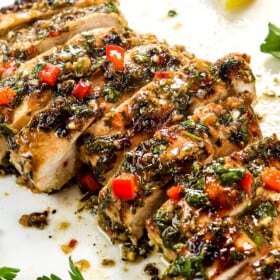
Chimichurri Chicken Breast
Save This Recipe To Your Recipe Box
You can now create an account on our site and save your favorite recipes all in one place!
Ingredients
CHICKEN
- 1 1/4-1 1/2 pounds chicken breasts, pounded to an even thickness
CHIMICHURRI SAUCE/MARINADE
- 1 shallot, peeled
- 3-4 garlic cloves, peeled
- 1-2 small red chilies, seeded (OR sub ½-1 tsp red pepper flakes)
- 3 tablespoons red wine vinegar
- 1 tablespoon lemon juice
- 1/2 teaspoon salt
- 1/4 teaspoon pepper
ADD LAST
- 1 cup packed flat-leaf parsley
- 1/2 cup packed cilantro (may sub flat-leaf parsley)
- 2 tablespoon fresh oregano or 2 tsp dried
- 1/2 cup olive oil
Instructions
MAKE CHIMICHURRI
- Add shallot, garlic, chili peppers/flakes, red wine vinegar, lemon juice and salt and pepper to a food processor. Pulse, stopping and scraping down sides occasionally until finely minced (or mince by hand).
- Add parsley, cilantro and oregano; pulse until the herbs are almost chopped to desired consistency.
- Pour in the olive oil while pulsing to combine, just until the herb leaves are finely minced but still have some body. Don’t over-process once you add the olive oil or the chimichurri can taste bitter. Add additional red wine vinegar for tangier, red pepper flakes for spicier or salt and pepper if desired.
MARINATE CHICKEN
- Remove ⅓ cup chimichurri for topping cooked chicken. Add remaining chimichurri to a freezer bag or bowl, add chicken and toss to evenly combine. Marinate for 30 minutes at room temperature or refrigerate up to 12 hours (the longer the better). Refrigerate the reserved ⅓ cup chimichurri sauce seprately.
- When ready to cook, remove chicken and chimichurri from the refrigerator and let rest 15-30 minutes before cooking.
TO GRILL CHICKEN:
- Preheat grill to 400 degrees with the lid closed, clean and grease grates.
- Grill chicken undisturbed with the lid closed for 5-7 minutes per side, until chicken is cooked through. (Cook to 160 degrees F on an instant read thermometer, then allow to rest for 5 minutes to carryover to 165 degrees F.)
- Top cooked chicken with reserved chimichurri (that never touched the raw chicken). Season with freshly cracked salt to taste.
TO COOK CHICKEN ON THE STOVE:
- Heat 1 tablespoon olive oil in a large non-stick skillet or indoor grill pan over medium-high heat. Once very hot, add chicken and cook, undisturbed, for 3-4 minutes, or until deeply golden on one side.
- Flip chicken over, cover, and reduce heat to medium. Cook for approximately 5-7 more minutes (depending on thickness of chicken), or until chicken is cooked to 160 degrees F on an instant read thermometer, then allowed to rest for 5 minutes to carryover to 165 degrees F.
- Top cooked chicken with reserved chimichurri (that never touched the raw chicken). Season with freshly cracked salt to taste.
TO BAKE CHICKEN IN THE OVEN:
- Preheat oven to 425 degrees F. Lightly grease a 9×13 baking dish.
- Bake the chicken for 14 to 16 minutes (for small/medium breasts that are about 5-6 ounces), 16 to 20 minutes (for medium/large breasts that are 7 to 9 ounces), or 20 to 25 minutes (for larger breasts). As always, I recommend using an instant read meat thermometer for the most accurate/juiciest chicken. Cook to an internal temperature of 160 degrees F, then allow to rest for 5 minutes to carryover to 165 degrees F.
- Top cooked chicken with reserved chimichurri (that never touched the raw chicken). Season with freshly cracked salt to taste.
Video
Notes
Tips and Tricks
- Chicken: This Chicken Chimichurri will work with any cut of chicken including chicken breasts, chicken thighs, chicken tenderloins, chicken drumsticks, chicken legs or chicken wings. You will just need to adjust the cooking times if you swap out the cut of chicken, so keep that meat thermometer handy!
- Parsley: Please use flat leaf parsley rather than curly parsley. Flat leaf parsley is bold and aromatic, while curly parsley can be muted and is used more for a garnish. To avoid bitter chimichurri, always taste the parsley before making to ensure you don’t ruin the entire batch.
- Shallot: Shallots enhance the sauce but aren’t traditional in chimichurri, so take them or leave them. One shallot is considered all of the bulbs within the shallot. You may also use ¼ of a red onion.
- Red wine vinegar: I don’t recommend substituting with white or balsamic vinegar. You may, however, substitute the lemon juice with additional red wine vinegar.
- Adjust to taste: If you’re not sure how strong, spicy or tangy you would like your chimichurri sauce, start with small amounts and gradually add more to taste. If the chicken tastes like it’s missing something, it is likely salt and/or heat.
- Ways to use Chimichurri Chicken: See post for lots of ideas!
How to Store and Reheat
- To store: Store cooked chicken in airtight containers in the refrigerator for 4-5 days.
- To freeze: Let the cooked chicken cool completely then transfer it to an airtight container or plastic freezer bag and squeeze out any excess air. If you want access to individual pieces of chicken without having to thaw all of the chicken, then wrap each chicken breast in plastic wrap before adding to the freezer bag. Freeze for 2 to 3 months. Let thaw completely in the refrigerator before reheating.
- To reheat in the microwave: Chop up or slice the chicken so it reheats more evenly then transfer a small portion to a microwave safe dish. Heat for 45 seconds then at 15 second intervals as needed.
- To reheat in the oven: Transfer chicken to an oven-proof dish. Cover with foil and reheat at 350 degrees F for 10 minutes or just until warmed through.

Did You Make This Recipe?
Tag @CarlsbadCravings and Use #CarlsbadCravngs
Leave a Review, I Always Love Hearing From You!
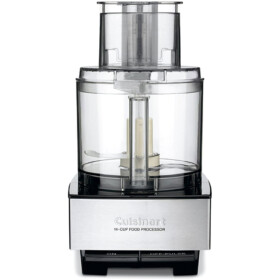
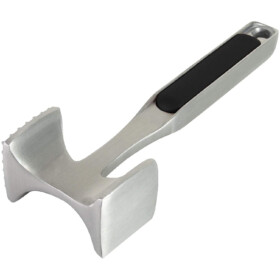
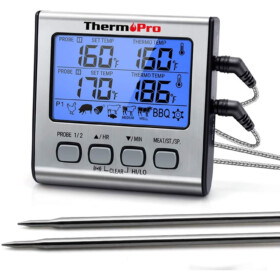

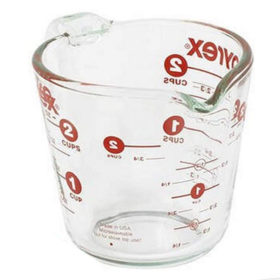
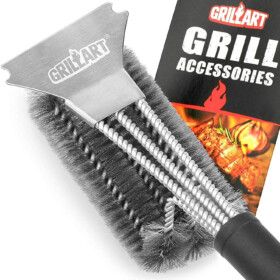
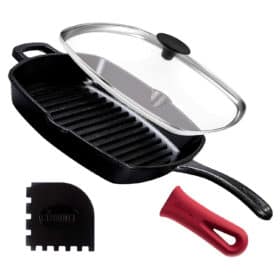
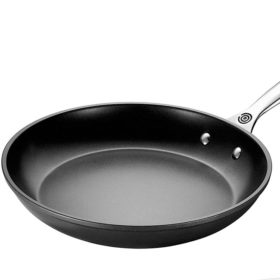
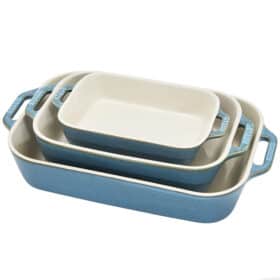
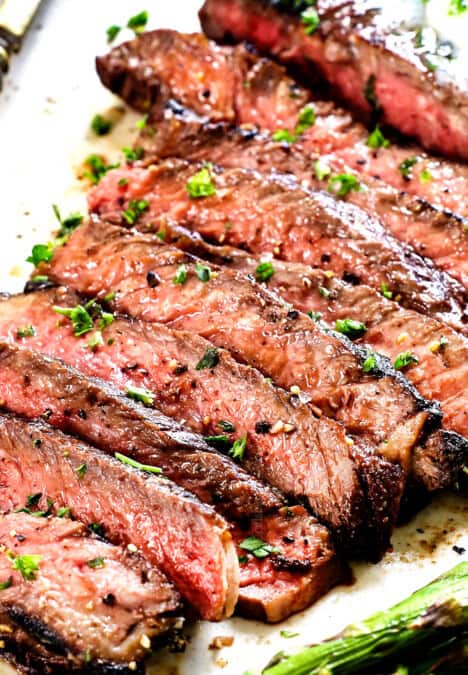

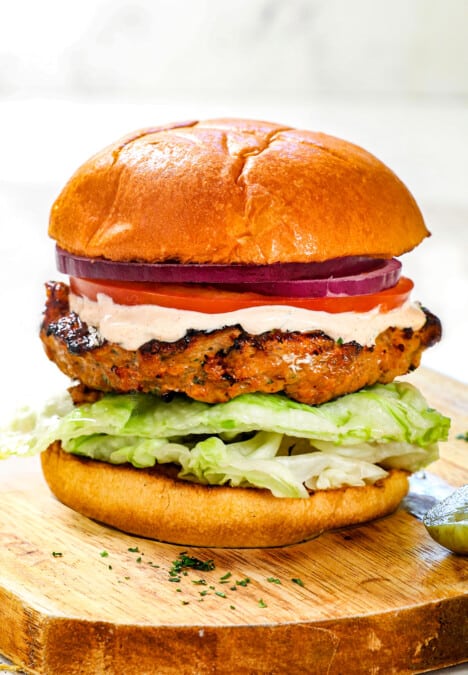
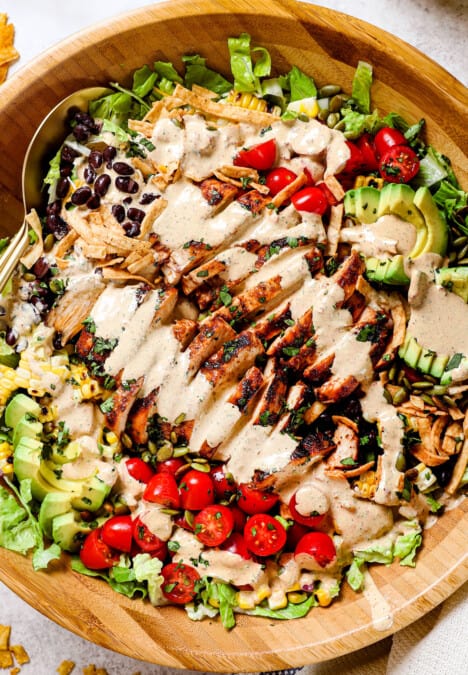
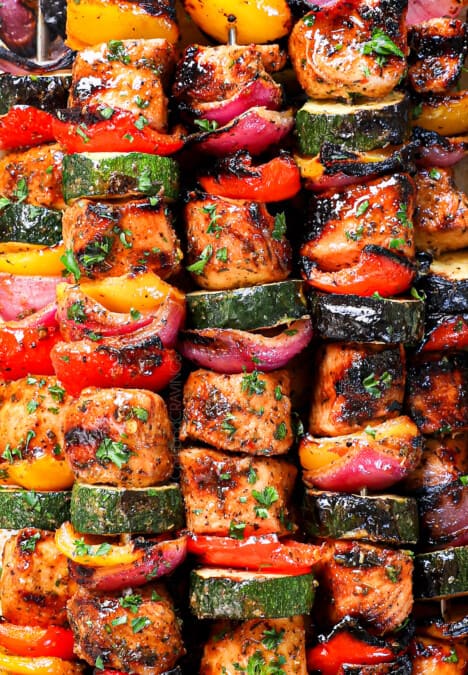
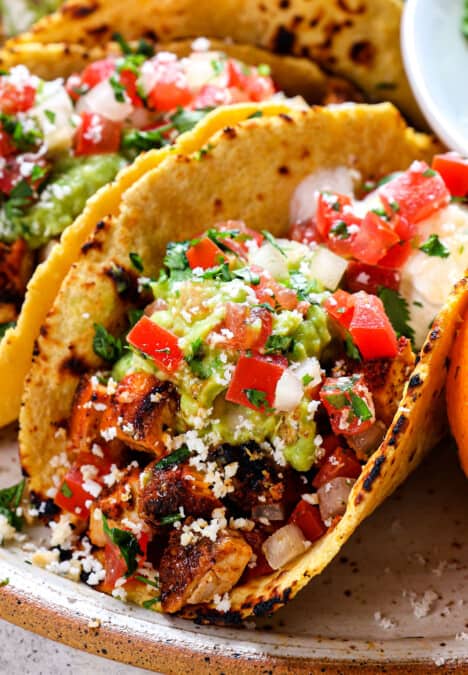























Laurie Gallop says
Omgosh this is amazing. You have so many amazing receipes you share but this one is the bomb
Jen says
That is awesome you made it already! I’m thrilled you loved it so much, thanks Laurie!
Cheryl says
Where do I even start! This recipe was my most recent make from a longggg list of your recipes. We shared it with our boys to cap off a great Father’s day and a birthday!
Jen, your recipes are totally amazing. Inspiring, delicious, fresh! Your recipes are super informative on how to prepare ahead of time, how to store, ingredient substitutions, what to serve with. I have tried no less than thirty of your creations and not once have I been disappointed. I have shared your recipes and website with friends, family, co workers…. Anyone that will listen! If I am looking for inspiration, Carlsbad Cravings is my first stop. I can’t thank you enough for inspiring me and bringing joy to what can sometimes be a mundane task – cooking. I take you camping with me, you have travelled to destinations with me and you are very often around my Sunday dinner table. Thank you from the bottom of my heart. ♥️ Keep those creative juices flowing.
Jen says
Hi Cheryl! I have been working my way through a backlog of comments and see yours somehow got lost in the mix. I am so honored that my recipes have been with you wherever you go! I appreciate you and hope you’re well!